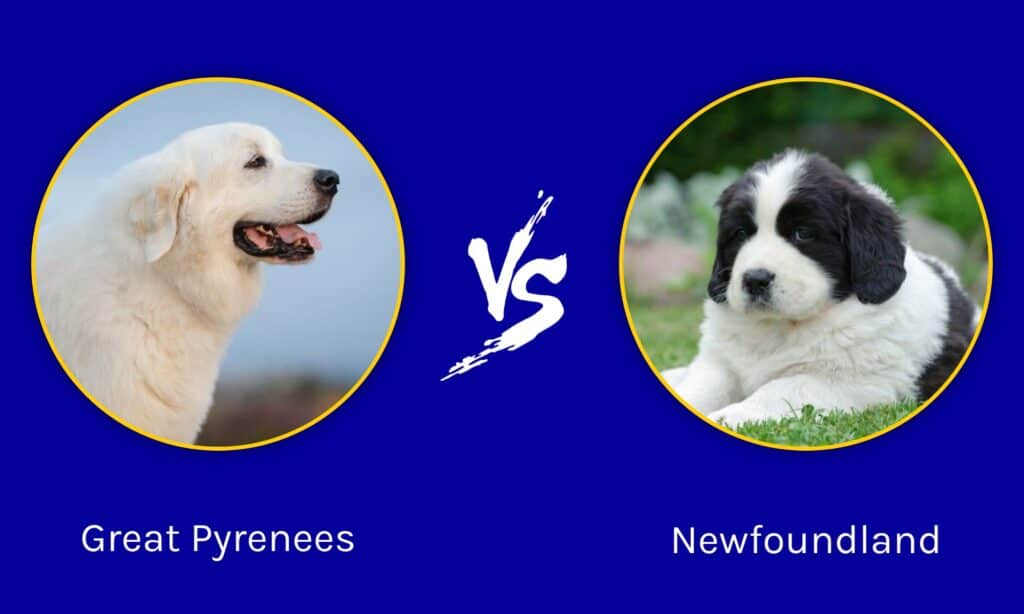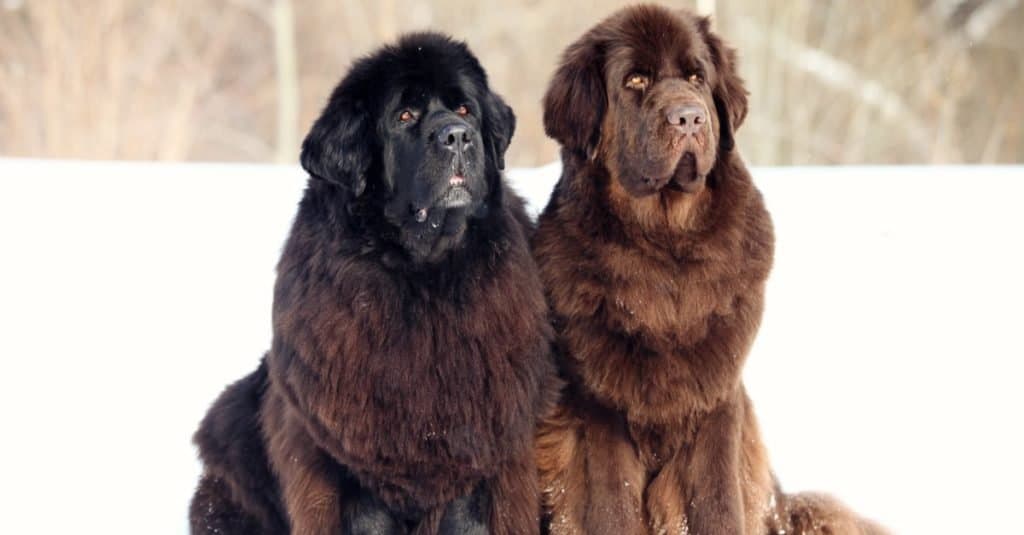Great Pyrenees vs Newfoundland: Key Differences Explained
@media (min-width: 481px) {
.mobile-top-content {
display: none;
}
}
#mobileTopContentCTACarouselControls { overflow: hidden; text-overflow: ellipsis; white-space: nowrap; }
.mobile-top-content .more { color: #fff; }
.mobile-top-content a { color: #fff; text-decoration: underline; }
.mobile-top-content a:hover { color: #fff; text-decoration: underline; }
@media (max-width: 480px) {
.mobile-top-content {
background-color: #06a10b;
color: #fff;
text-align: center;
/*height: 60px;
padding-top:5px;*/
font-size:80%;
/* display: block; */
margin: 0px -30px;
}
}
The Great Pyrenees and Newfoundland are two remarkably similar breeds, bred for guarding livestock yet remaining incredibly affectionate with family. Great Pyrs have rounder snouts and ears that sit further back on their heads. Newfoundlands are excellent with strangers, drool plentifully, and bark only occasionally.
Want to learn more about these protective breeds? Let’s dive in!
Comparing Great Pyrenees vs Newfoundland

A-Z-Animals.com
button.pulse {
transform: scale(1); animation: pulse 2s infinite;
box-shadow: 0 0 0 0 rgba(11, 247, 25, 1);
}
@keyframes pulse {
0% { transform: scale(0.90); box-shadow: 0 0 0 0 rgba(11, 247, 25, 0.5); }
60% { transform: scale(1); box-shadow: 0 0 0 15px rgba(11, 247, 25, 0); }
100% { transform: scale(0.90); box-shadow: 0 0 0 0 rgba(11, 247, 25, 0); }
}
| Great Pyrenees | Newfoundland | |
|---|---|---|
| Size | 25-32 inches, 85+ pounds | 26-28 inches, 100-150 pounds |
| Appearance | Rounder face, ears set far back on the head, fur may be black, brown, grey, or white and black | Boxy snout, ears set forward on the head, white fur with tan, grey, badger, or reddish-brown markings |
| Lifespan | 10-12 years | 8-10 years |
| Temperament | Can be wary around strange people and dogs | Excellent with children and other dogs, friendly toward strangers |
| Drooling Level | Moderate | High |
| Barking Level | Moderate | Low |
Key Differences Between Great Pyrenees and Newfoundland
The primary difference between Great Pyrenees dogs and Newfoundlands is their friendliness toward strangers. Their key differences include size, appearance, lifespan, drooling level, and barking level.
Let’s dive into these characteristics below to see what makes these pups so unique!
Great Pyrenees vs Newfoundland: Size
Great Pyrenees dogs are 25-32 inches tall. Females weigh more than 85 pounds, and males weigh over 100 pounds. There is no upper weight limit set by the AKC breed standard.
Newfoundlands stand 26-28 inches tall and weigh 100-150 pounds.
Female Great Pyrenees dogs weigh quite a bit less than Newfoundlands, while males are similar in size. Male Pyrs are often larger than Newfoundlands, though not always!
Great Pyrenees vs Newfoundland: Appearance

iStock.com/Dixi_
Newfoundlands have slightly shorter, boxier snouts than Great Pyrs. They also have ears that appear larger and sit forward on the face, while Great Pyrenees dogs have tiny, triangular ears that can almost blend into their fur!
Speaking of fur, these breeds have different coat colors as well.
According to breed standard, Newfoundlands can be any of the following colors:
- Black
- Brown
- Grey
- White and black
Great Pyrenees dogs can only be white with markings that are tan, grey, badger, or reddish-brown in color.
Great Pyrenees vs Newfoundland: Lifespan
Newfoundlands live 8-10 years on average, while Great Pyrenees dogs typically live 10-12 years. This means that most Great Pyrs will live longer lives than most Newfoundlands.
However, this isn’t an absolute guarantee. Some dogs, unfortunately, will live below their expected lifespan, while others will surpass it by many years. Genetics, veterinary care, diet, exercise, and daily care all play a part in how long your dog will live.
Great Pyrenees vs Newfoundland: Temperament

everydoghasastory/Shutterstock.com
Both of these dogs have very strong guarding instincts. They are alert and ready to protect, just like they were bred to do. However, Newfoundlands tend to be a lot friendlier with strangers. This extends to strange dogs and children.
Great Pyrs tend to take time to warm up to strangers. They’re less adaptable than Newfoundlands, but once they know their family has accepted someone, they’ll learn to love them too!
With family, both breeds are incredibly affectionate and maybe even clingy. It’s important that you don’t adopt these dogs unless you have time for them. They do best in a family where someone is home most of the day.
However, you should also teach your dog how to be comfortable alone for short periods. This will lessen their chances of developing separation anxiety.
Great Pyrenees vs Newfoundland: Drooling Level
Great Pyrenees dogs are moderate droolers. You’ll notice this the most around their food and water bowls, at your feet when they’re begging for a biscuit, and where they sleep.
Newfoundlands have the tendency to drool everywhere. You’ll have to wipe up after them and keep their face clean. Some days it might feel like you should just follow them around with a mop!
Great Pyrenees vs Newfoundland: Barking Level

Pandas/Shutterstock.com
Great Pyrs are moderate barkers. They don’t tend to bark excessively but can if they’re not given proper care and training.
Newfoundlands tend to bark when they see something of note, like a stranger approaching the house—or the mail carrier they see every day!
If your dog barks excessively, try prevention before training. This includes ensuring your pup has had enough exercise, mental stimulation, and attention. Remember that these dogs don’t like being left alone for long periods and may act up while you’re away, especially if they’ve developed separation anxiety.
Once you’ve eliminated these causes, some basic training is in order. Teach your dog the “speak” command, then use it to teach “quiet.”
Start with a controlled setting where you’ve told your dog to speak, then move to more difficult sessions. As with all training, you want to set your dog up for success—so don’t repeat “quiet” over and over as they bark, but instead wait for them to stop before rewarding that behavior.
Ready to discover the top 10 cutest dog breeds in the entire world?
How about the fastest dogs, the largest dogs and those that are — quite frankly — just the kindest dogs on the planet? Each day, AZ Animals sends out lists just like this to our thousands of email subscribers. And the best part? It’s FREE. Join today by entering your email below.
More from A-Z Animals
.more-snake-card-image { max-height:140px !important; }
@media (min-width: 481px) {
.mobile-top-content {
display: none;
}
}
#mobileTopContentCTACarouselControls { overflow: hidden; text-overflow: ellipsis; white-space: nowrap; }
.mobile-top-content .more { color: #fff; }
.mobile-top-content a { color: #fff; text-decoration: underline; }
.mobile-top-content a:hover { color: #fff; text-decoration: underline; }
@media (max-width: 480px) {
.mobile-top-content {
background-color: #06a10b;
color: #fff;
text-align: center;
/*height: 60px;
padding-top:5px;*/
font-size:80%;
/* display: block; */
margin: 0px -30px;
}
}
The Great Pyrenees and Newfoundland are two remarkably similar breeds, bred for guarding livestock yet remaining incredibly affectionate with family. Great Pyrs have rounder snouts and ears that sit further back on their heads. Newfoundlands are excellent with strangers, drool plentifully, and bark only occasionally.
Want to learn more about these protective breeds? Let’s dive in!
Comparing Great Pyrenees vs Newfoundland

A-Z-Animals.com
button.pulse {
transform: scale(1); animation: pulse 2s infinite;
box-shadow: 0 0 0 0 rgba(11, 247, 25, 1);
}
@keyframes pulse {
0% { transform: scale(0.90); box-shadow: 0 0 0 0 rgba(11, 247, 25, 0.5); }
60% { transform: scale(1); box-shadow: 0 0 0 15px rgba(11, 247, 25, 0); }
100% { transform: scale(0.90); box-shadow: 0 0 0 0 rgba(11, 247, 25, 0); }
}
| Great Pyrenees | Newfoundland | |
|---|---|---|
| Size | 25-32 inches, 85+ pounds | 26-28 inches, 100-150 pounds |
| Appearance | Rounder face, ears set far back on the head, fur may be black, brown, grey, or white and black | Boxy snout, ears set forward on the head, white fur with tan, grey, badger, or reddish-brown markings |
| Lifespan | 10-12 years | 8-10 years |
| Temperament | Can be wary around strange people and dogs | Excellent with children and other dogs, friendly toward strangers |
| Drooling Level | Moderate | High |
| Barking Level | Moderate | Low |
Key Differences Between Great Pyrenees and Newfoundland
The primary difference between Great Pyrenees dogs and Newfoundlands is their friendliness toward strangers. Their key differences include size, appearance, lifespan, drooling level, and barking level.
Let’s dive into these characteristics below to see what makes these pups so unique!
Great Pyrenees vs Newfoundland: Size
Great Pyrenees dogs are 25-32 inches tall. Females weigh more than 85 pounds, and males weigh over 100 pounds. There is no upper weight limit set by the AKC breed standard.
Newfoundlands stand 26-28 inches tall and weigh 100-150 pounds.
Female Great Pyrenees dogs weigh quite a bit less than Newfoundlands, while males are similar in size. Male Pyrs are often larger than Newfoundlands, though not always!
Great Pyrenees vs Newfoundland: Appearance

iStock.com/Dixi_
Newfoundlands have slightly shorter, boxier snouts than Great Pyrs. They also have ears that appear larger and sit forward on the face, while Great Pyrenees dogs have tiny, triangular ears that can almost blend into their fur!
Speaking of fur, these breeds have different coat colors as well.
According to breed standard, Newfoundlands can be any of the following colors:
- Black
- Brown
- Grey
- White and black
Great Pyrenees dogs can only be white with markings that are tan, grey, badger, or reddish-brown in color.
Great Pyrenees vs Newfoundland: Lifespan
Newfoundlands live 8-10 years on average, while Great Pyrenees dogs typically live 10-12 years. This means that most Great Pyrs will live longer lives than most Newfoundlands.
However, this isn’t an absolute guarantee. Some dogs, unfortunately, will live below their expected lifespan, while others will surpass it by many years. Genetics, veterinary care, diet, exercise, and daily care all play a part in how long your dog will live.
Great Pyrenees vs Newfoundland: Temperament

everydoghasastory/Shutterstock.com
Both of these dogs have very strong guarding instincts. They are alert and ready to protect, just like they were bred to do. However, Newfoundlands tend to be a lot friendlier with strangers. This extends to strange dogs and children.
Great Pyrs tend to take time to warm up to strangers. They’re less adaptable than Newfoundlands, but once they know their family has accepted someone, they’ll learn to love them too!
With family, both breeds are incredibly affectionate and maybe even clingy. It’s important that you don’t adopt these dogs unless you have time for them. They do best in a family where someone is home most of the day.
However, you should also teach your dog how to be comfortable alone for short periods. This will lessen their chances of developing separation anxiety.
Great Pyrenees vs Newfoundland: Drooling Level
Great Pyrenees dogs are moderate droolers. You’ll notice this the most around their food and water bowls, at your feet when they’re begging for a biscuit, and where they sleep.
Newfoundlands have the tendency to drool everywhere. You’ll have to wipe up after them and keep their face clean. Some days it might feel like you should just follow them around with a mop!
Great Pyrenees vs Newfoundland: Barking Level

Pandas/Shutterstock.com
Great Pyrs are moderate barkers. They don’t tend to bark excessively but can if they’re not given proper care and training.
Newfoundlands tend to bark when they see something of note, like a stranger approaching the house—or the mail carrier they see every day!
If your dog barks excessively, try prevention before training. This includes ensuring your pup has had enough exercise, mental stimulation, and attention. Remember that these dogs don’t like being left alone for long periods and may act up while you’re away, especially if they’ve developed separation anxiety.
Once you’ve eliminated these causes, some basic training is in order. Teach your dog the “speak” command, then use it to teach “quiet.”
Start with a controlled setting where you’ve told your dog to speak, then move to more difficult sessions. As with all training, you want to set your dog up for success—so don’t repeat “quiet” over and over as they bark, but instead wait for them to stop before rewarding that behavior.
Ready to discover the top 10 cutest dog breeds in the entire world?
How about the fastest dogs, the largest dogs and those that are — quite frankly — just the kindest dogs on the planet? Each day, AZ Animals sends out lists just like this to our thousands of email subscribers. And the best part? It’s FREE. Join today by entering your email below.














